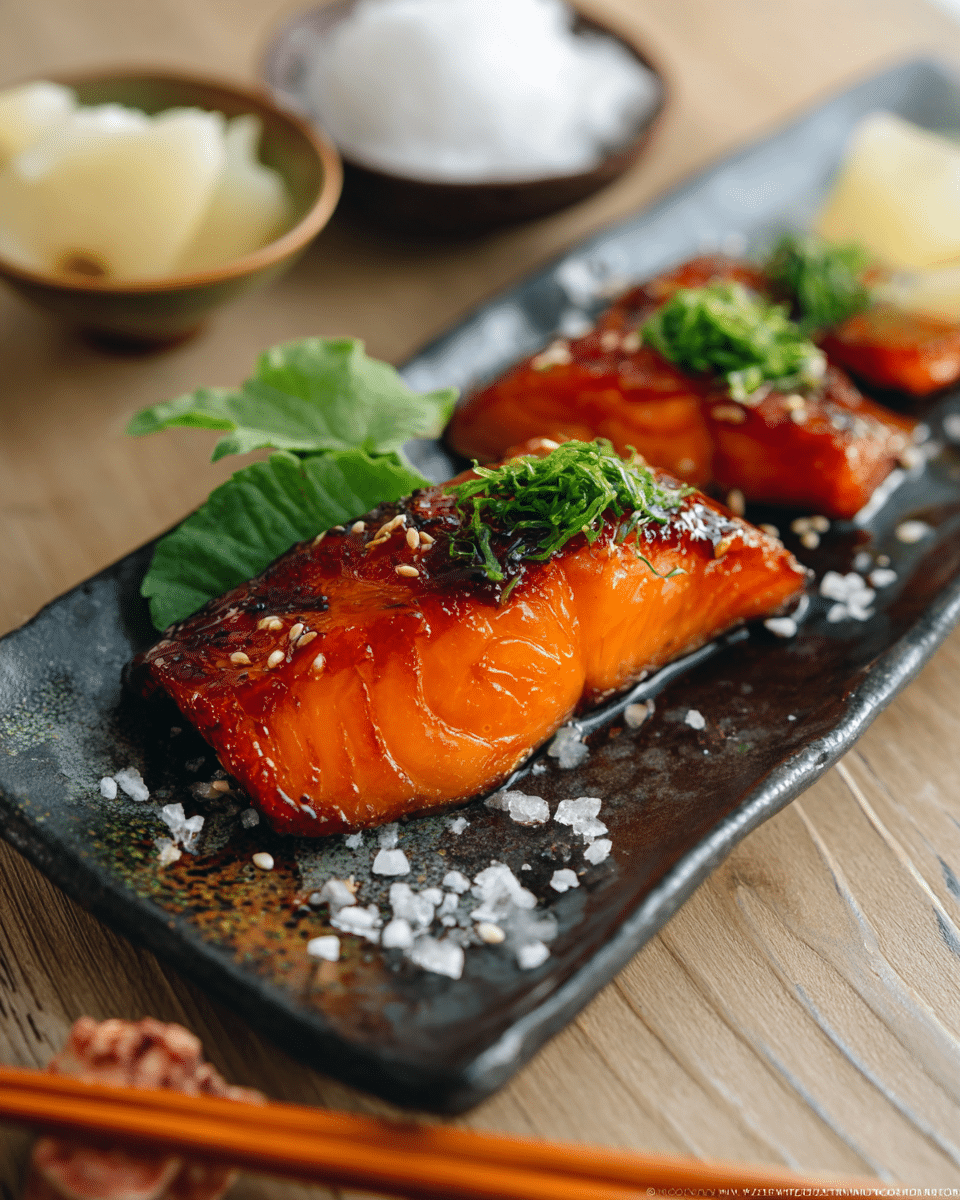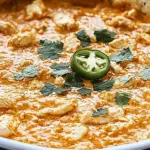The tradition of kasuzuke (marinating in sake lees) dates back centuries in Japanese cuisine, and Salmon Kasuzuke is a prime example of how fermentation enhances flavor and texture. This dish offers a gentle sweetness and umami depth that pairs beautifully with steamed rice and seasonal sides, making it both comforting and refined.
By letting the fish marinate for several days, the sake kasu deeply infuses the salmon with complex flavors, while the grilling process brings out a slightly caramelized, crispy exterior. It’s a showcase of Japanese culinary technique simple ingredients, time, and balance.
Full Recipe:
Ingredients:
-
4 salmon fillets (skin-on, about 5 oz each)
-
1 cup sake kasu (sake lees)
-
3 tablespoons mirin
-
3 tablespoons sake
-
2 tablespoons sugar
-
1 tablespoon miso (white or red)
-
Salt for initial seasoning
Directions:
-
Lightly season the salmon fillets with salt and let them rest for 30–60 minutes. This helps draw out excess moisture and improves flavor.
-
In a small saucepan over low heat, combine sake kasu, mirin, sake, sugar, and miso. Stir until smooth and just warm do not boil. Let it cool completely.
-
Pat the salmon dry with paper towels and place in a sealable container or Ziploc bag.
-
Slather the cooled marinade all over the salmon fillets, ensuring each piece is fully coated. Refrigerate for at least 2 days, up to 5 days for a deeper flavor.
-
When ready to cook, gently scrape off excess marinade from each fillet. Do not rinse.
-
Preheat broiler or grill to medium heat (375–400°F). Cook salmon skin-side down for 4–5 minutes on each side or until the skin crisps and the interior is cooked through.
-
Serve with steamed rice and seasonal pickles for a traditional touch.
Prep Time: 10 minutes (plus 2–5 days marinating)
Cooking Time: 10 minutes
Total Time: ~20 minutes active, 2–5 days total
Kcal: 290 kcal | Servings: 4 servings
Salmon Kasuzuke: A Fermented Legacy from Japanese Culinary Tradition
In the ever-evolving world of global cuisine, few dishes embody the depth, patience, and heritage of Japanese cooking quite like Salmon Kasuzuke. More than just a grilled fish dish, Salmon Kasuzuke is a beautifully preserved culinary tradition that speaks to the heart of Japanese fermentation techniques, seasonal eating, and minimalist but profound flavor development.
Rooted in centuries-old methods of food preservation, this dish encapsulates the essence of Japanese values: respect for ingredients, dedication to craftsmanship, and harmony with nature. Whether you’re a lover of traditional Japanese flavors or a newcomer to the realm of fermented foods, Salmon Kasuzuke offers a rich, umami packed experience that is both nostalgic and surprisingly modern.
Origins and Cultural Significance of Kasuzuke
To understand Salmon Kasuzuke, one must first delve into the broader practice of kasuzuke, a traditional Japanese method of pickling and preserving using sake kasu, the lees or paste left over from sake production. For centuries, kasuzuke has been used to ferment vegetables, meats, and fish. It dates back to the Heian period (794–1185) and was especially popular during the Edo period when preservation methods were vital to ensure food sustainability before refrigeration.
The use of sake kasu was not merely practical; it was an extension of Japanese frugality and respect for by products. Sake kasu is nutrient-rich, filled with amino acids and enzymes, and offers a slightly sweet, pungent flavor that imparts complexity to whatever it touches. This paste not only tenderizes the fish but also slowly ferments it, imbuing it with a depth of flavor that is difficult to achieve through other means.
In the case of Salmon Kasuzuke, the marriage of rich salmon flesh with aromatic sake lees creates a deeply satisfying contrast: soft, fatty fish meets a sharp, almost tangy marinade that transforms into something almost caramelized when grilled.
The Beauty of Fermentation in Japanese Cuisine
Fermentation is one of the cornerstones of Japanese culinary philosophy. From miso to soy sauce, natto to tsukemono (pickled vegetables), Japan has long embraced the microbial magic of fermentation for preservation and flavor enhancement.
In Salmon Kasuzuke, the fermentation process is gentle yet transformative. By marinating the salmon in sake kasu for two to five days, the fish undergoes a slow, enzymatic metamorphosis. This process breaks down proteins and enhances umami, giving the salmon a soft, melt-in-your-mouth texture while also extending its shelf life.
The longer the marination period, the deeper the flavors. A 2 day marination offers a subtle sweetness and mild depth, while 4 to 5 days yield an intensely umami rich profile with slight cheese like nuances. However, the flavor never feels overpowering it remains delicate, balanced, and utterly Japanese.
A Dish Rooted in Seasonality and Ritual
Traditionally, Salmon Kasuzuke is enjoyed during winter and early spring, coinciding with the sake brewing season in Japan. This seasonal alignment is no accident fresh sake kasu is most plentiful during this time, and the hearty, warming nature of fermented fish fits perfectly with colder weather meals.
It’s also a dish deeply tied to family and home cooking, passed down through generations, particularly in regions like Kansai and Hokuriku, where sake brewing has long thrived. For many Japanese households, the preparation and sharing of kasuzuke is a yearly ritual, much like kimchi preparation in Korean homes.
Flavor Profile and Cooking Characteristics
Salmon Kasuzuke has a flavor that’s difficult to categorize within Western culinary terms. It’s umami-forward, slightly sweet, faintly sour from the fermentation, and occasionally carries the subtle notes of miso or mirin, depending on the marinade mix. Once grilled or broiled, the sugars in the sake kasu caramelize on the surface of the salmon, creating a lightly charred crust that contrasts beautifully with the soft, moist flesh underneath.
Unlike Western marinades which often focus on adding surface flavor, kasuzuke penetrates deep into the protein, flavoring the fish all the way through. The result is a layered complexity: a firm bite followed by an almost creamy interior and a lingering, rich aftertaste.
Because of its intensity and richness, Salmon Kasuzuke is typically served with steamed white rice, pickled vegetables, or miso soup. It is not meant to be the loud centerpiece of a meal, but rather a perfectly balanced harmony of taste and tradition within a larger, multi-course arrangement known as ichiju-sansai (one soup, three dishes).
Health Benefits of Salmon Kasuzuke
Beyond its taste and cultural heritage, Salmon Kasuzuke also boasts several health benefits. Fermented foods are rich in probiotics, enzymes, and amino acids that aid digestion and support gut health. Sake kasu itself contains ferulic acid, peptides, and vitamin B, all of which contribute to anti-inflammatory and skin health properties.
Salmon, of course, is packed with omega-3 fatty acids, protein, and vitamin D. When combined, the fermentation and fish offer a meal that’s not just delicious but also nutritionally dense.
Furthermore, the traditional cooking method grilling or broiling without added oil makes this a relatively low fat, heart healthy dish compared to pan fried or heavily sauced alternatives.
Serving Suggestions and Modern Twists
While purists prefer to enjoy Salmon Kasuzuke with rice and pickles, modern adaptations have brought this dish into contemporary kitchens in unique ways:
-
Kasuzuke Bento Boxes: Salmon Kasuzuke makes an elegant main protein in a Japanese-style lunchbox, paired with tamagoyaki, pickled daikon, and sesame spinach.
-
Salmon Kasuzuke Rice Bowls: Serve flaked grilled kasuzuke salmon over sushi rice, topped with avocado, nori strips, and a soft-boiled egg for a Japanese rice bowl twist.
-
Kasuzuke Tacos: For a fusion take, wrap grilled salmon kasuzuke in nori “tortillas” with shredded cabbage and spicy miso mayo.
-
Appetizer Skewers: Cubed kasuzuke salmon grilled on skewers can make a perfect izakaya-style appetizer when paired with sake.
Additionally, vegetarian chefs have begun experimenting with kasuzuke-style marinades on tofu, eggplant, or mushrooms to replicate the fermentation effect in plant-based dishes.
Why This Dish Belongs on Your Table
Salmon Kasuzuke is a recipe that speaks volumes with very little. There are no exotic techniques, flashy garnishes, or complex flavor fusions just a simple piece of fish, a humble sake by product, and time.
Yet it’s exactly this simplicity that makes it remarkable. It invites mindfulness. You’re not just eating a meal you’re experiencing a history, participating in a centuries old ritual, and savoring a craft honed by generations.
At a time when fermented foods are gaining global acclaim for both their flavor and health benefits, Salmon Kasuzuke stands out as a prime example of how traditional knowledge can yield both nourishment and sophistication. Whether served in a fine dining setting or enjoyed quietly at home, it’s a dish that deserves more recognition beyond Japanese borders.
Conclusion:
Salmon Kasuzuke is more than just another salmon recipe it’s a culinary time capsule that showcases the elegance of Japanese preservation techniques and the quiet genius of fermentation. Rooted in sustainability, wellness, and deep flavor, this dish bridges the past and present, offering a nourishing experience for both the body and soul.
From its slow marination in sake kasu to its smoky, umami-laden finish on the grill, Salmon Kasuzuke embodies the patience and depth that define traditional Japanese cooking. If you’re looking to expand your understanding of fermentation or dive deeper into Japan’s lesser-known culinary treasures, this dish is the perfect place to start.






